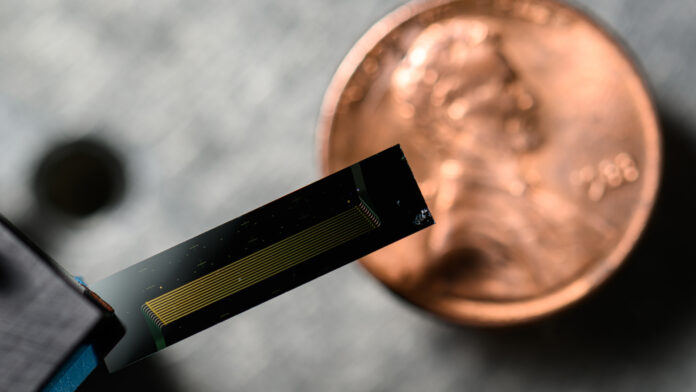"Revolutionizing Navigation: The Penny-Sized Laser Set to Transform Autonomous Vehicles"
Penny-Sized Laser Revolutionizes Autonomous Vehicle Navigation
Date: [Insert Date]
Location: University of Rochester, NY & University of California, Santa Barbara
In a groundbreaking development, researchers from the University of Rochester and the University of California, Santa Barbara have unveiled a penny-sized laser that promises to significantly enhance the navigation capabilities of autonomous vehicles. This innovative laser is designed to improve optical metrology, a scientific technique that utilizes light to measure and identify objects, thereby paving the way for more accurate and efficient lidar (light detection and ranging) systems.
Advancements in Lidar Technology
Current lidar systems, which are crucial for autonomous vehicles, utilize lasers that are invisible to the human eye to gather data about the size, distance, and velocity of surrounding objects, including pedestrians and other vehicles. However, the research team argues that existing lidar technologies are often overly complex and prone to inaccuracies. Their new laser solution aims to address these shortcomings by enabling the collection of sophisticated data at unprecedented speeds and accuracy.
Lead author Shixin Xue, a doctoral student in electrical and computer engineering and optics at the University of Rochester, explained, "A more advanced form of lidar known as frequency-modulated continuous-wave LiDAR requires a large tuning range and fast tuning of the laser’s frequency, and that’s what our laser can do."
Demonstrating Precision and Speed
The researchers showcased the laser’s capabilities by successfully identifying letters "U" and "R" made from Lego bricks on a spinning disk. This demonstration highlights the laser’s ability to track fast-moving objects—an essential feature for the safe navigation of autonomous vehicles.
The study detailing this innovation was published on May 30 in the journal Light: Science & Applications. The researchers emphasized that their laser can emit an astonishing 20 quintillion pulses of light per second, allowing it to measure objects moving at speeds of up to 131 feet per second (40 meters per second) from a distance of 1.3 feet (0.4 meters). Remarkably, the laser has also shown reliability, operating continuously for up to 60 minutes.
Compact Design and Future Applications
One of the most significant advantages of this new laser is its compact design. Traditionally, the equipment required for a process known as Pound-Drever-Hall (PDH) laser frequency locking—essential for stabilizing a laser’s noise—would occupy the space of a desktop computer. Xue noted, "Our laser can integrate all of these things into a very small chip that can be tuned electrically."
This miniaturization could lead to the development of autonomous vehicles equipped with lidar systems that are not only more efficient but also aerodynamically optimized. Current systems, such as those used in Waymo vehicles, often require bulky sensors that can hinder vehicle performance. The new laser could facilitate the creation of vehicles with lower air drag, including autonomous aircraft, and could also be applied in fields requiring highly accurate lasers, such as quantum information processing and gravitational wave detection.
Support from DARPA
The research received partial funding from the U.S. Defense Advanced Research Projects Agency (DARPA) as part of its Lasers for Universal Microscale Optical Systems (LUMOS) program. This initiative aims to advance photonics technology by supporting the development of more complex and powerful optical systems.
As the automotive industry continues to evolve towards fully autonomous vehicles, innovations like this penny-sized laser could play a pivotal role in enhancing safety and efficiency on the roads. The implications of this research extend beyond transportation, potentially impacting various sectors that rely on precise optical measurements.
For further details, the full study can be accessed in Light: Science & Applications here.
This development marks a significant step forward in the quest for safer and more efficient autonomous navigation, showcasing the potential of cutting-edge technology to reshape the future of transportation.
